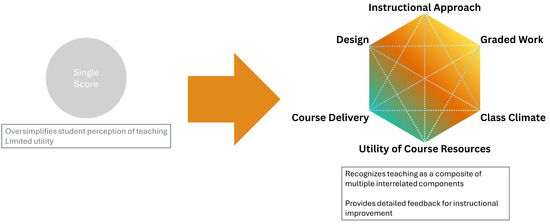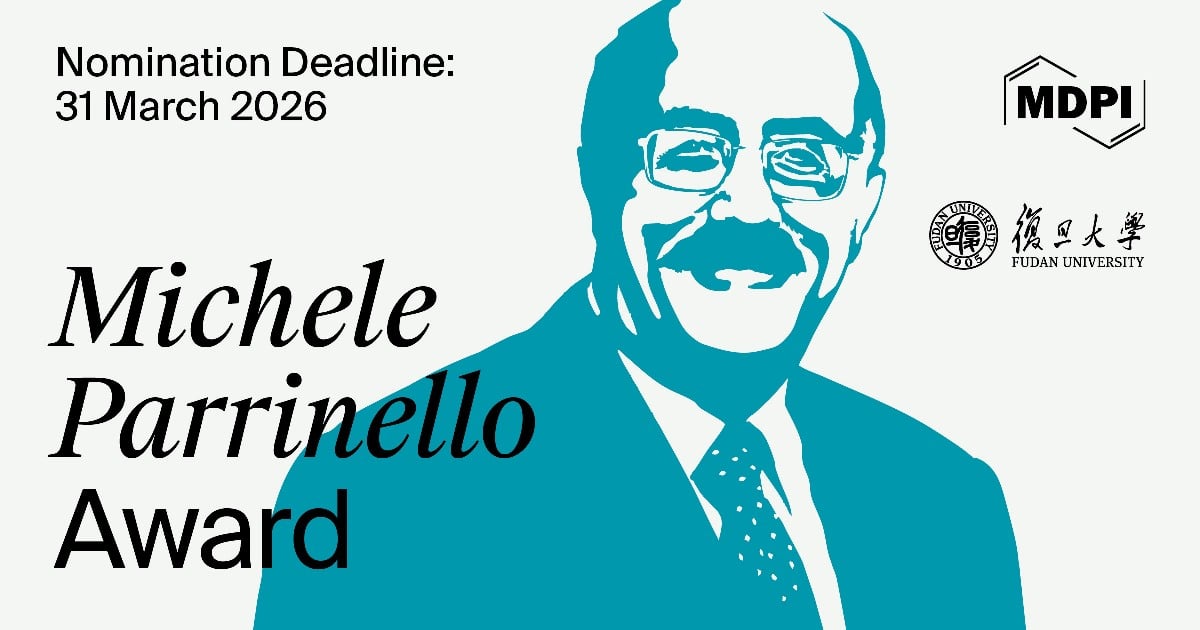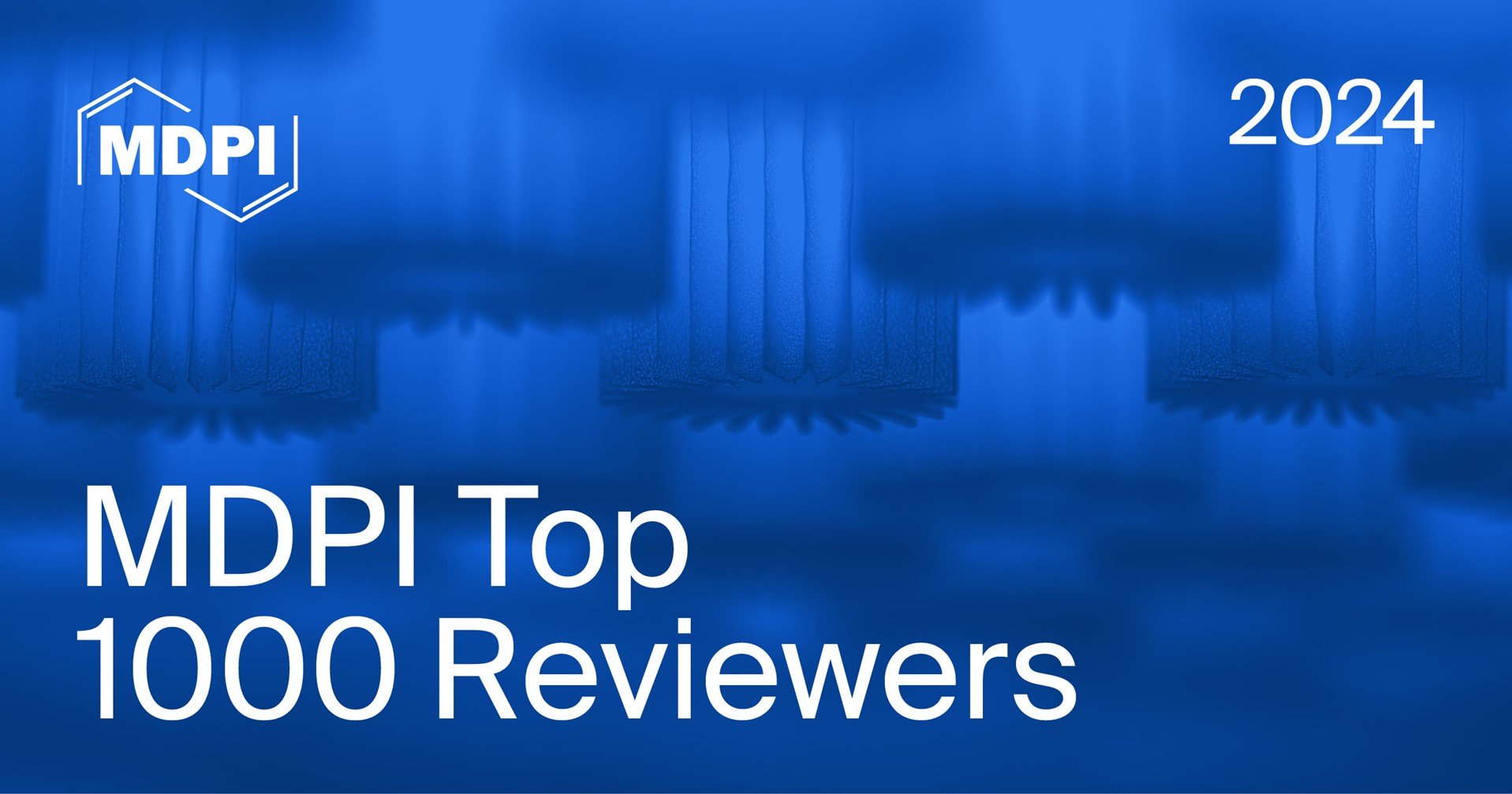Journal Description
Trends in Higher Education
Trends in Higher Education
is an international, peer-reviewed, open access journal on higher education published quarterly online by MDPI.
- Open Access— free for readers, with article processing charges (APC) paid by authors or their institutions.
- High Visibility: indexed within ESCI (Web of Science), Scopus and other databases.
- Rapid Publication: manuscripts are peer-reviewed and a first decision is provided to authors approximately 42 days after submission; acceptance to publication is undertaken in 5.6 days (median values for papers published in this journal in the first half of 2025).
- Recognition of Reviewers: APC discount vouchers, optional signed peer review, and reviewer names published annually in the journal.
Latest Articles
Evaluating the Validity of the Student Perspectives of Teaching Survey: A Network Psychometrics Approach
Trends High. Educ. 2025, 4(4), 74; https://doi.org/10.3390/higheredu4040074 - 27 Nov 2025
Abstract
►
Show Figures
Higher education institutions commonly employ student evaluation of teaching (SET) instruments (e.g., course evaluation surveys) to enhance course quality and inform instructional strategies. However, conceptualizing and measuring SET as a unidimensional construct may compromise validity, particularly when represented by a single aggregated score.
[...] Read more.
Higher education institutions commonly employ student evaluation of teaching (SET) instruments (e.g., course evaluation surveys) to enhance course quality and inform instructional strategies. However, conceptualizing and measuring SET as a unidimensional construct may compromise validity, particularly when represented by a single aggregated score. This study uses a network psychometrics approach to explore the validity of a new instrument that acknowledges the multidimensional nature of SET as an educational construct. The central research question is, “How is the robustness of a multidimensional students’ evaluation of the teaching survey?”. The study sample consists of 649 undergraduate students from a western Canadian university who completed a multidimensional SET instrument. The instrument consists of six subscales corresponding to six aspects of SET (i.e., design, utility of course resources, graded work, course delivery, instructional approach, and class climate). The findings revealed a robust line of evidence that supports the validity of the instrument’s interpretation and usage. This was demonstrated through a high coefficient alpha, good network model fit, and stable survey structure. The study provides evidence supporting the use of a multidimensional SET instrument and offers novel validity support via the structural evidence provided by network analysis.
Full article
Open AccessArticle
Great Expectations: Studying at a Regional Campus in Northwest Tasmania—A Pilot Study
by
Sarah J. Prior, Merete Schmidt, Stephanie Richey and Diana Guzys
Trends High. Educ. 2025, 4(4), 73; https://doi.org/10.3390/higheredu4040073 - 27 Nov 2025
Abstract
►▼
Show Figures
Studying at a university regional campus presents unique opportunities, challenges, and experiences for students. People who live in rural and regional areas are less likely to gain a tertiary degree, and barriers include access, cost, and competing priorities and aspirations. Students are often
[...] Read more.
Studying at a university regional campus presents unique opportunities, challenges, and experiences for students. People who live in rural and regional areas are less likely to gain a tertiary degree, and barriers include access, cost, and competing priorities and aspirations. Students are often from lower socio-economic status backgrounds, first in family, and have diverse caring responsibilities, needing a different approach to support when entering higher education. Many studies focus on transitions to higher education for a commencing student. However, student expectations of and engagement in their studies at a regional university are under-researched. Four cross-discipline researchers conducted a pilot study to determine the feasibility of a larger project investigating students’ expectations and experiences of studying at University of Tasmania’s regional Cradle Coast Campus to identify how to better support students in the first two years of their degrees. An online survey collected responses from students commencing a degree through on-campus study. Data were thematically analysed using recurrent abstraction. Five themes emerged under the overarching theme of great expectations. Data contributes to understanding the relevance of Kahu and Nelson’s framework, of student engagement in a regional context. Consideration of these findings will assist in supporting and engaging regional people in higher education.
Full article
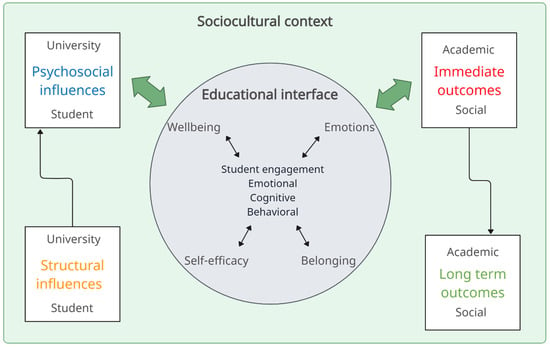
Figure 1
Open AccessArticle
From Local Disasters to Global Design Discourse: Interior Architecture Theses in Türkiye
by
Betül İrem Tarakçı
Trends High. Educ. 2025, 4(4), 72; https://doi.org/10.3390/higheredu4040072 - 26 Nov 2025
Abstract
Disaster is a multidimensional phenomenon affecting societies worldwide. Rising climate crises, mass migrations, and earthquake risks have made disaster awareness crucial in spatial design. In this context, interior architecture has evolved beyond esthetic and functional concerns into a discipline that contributes to post-disaster
[...] Read more.
Disaster is a multidimensional phenomenon affecting societies worldwide. Rising climate crises, mass migrations, and earthquake risks have made disaster awareness crucial in spatial design. In this context, interior architecture has evolved beyond esthetic and functional concerns into a discipline that contributes to post-disaster recovery and quality of life. This study examines disaster- and earthquake-themed postgraduate theses in interior architecture in Türkiye to identify academic trends and methodological orientations. Drawing on Türkiye’s distinctive disaster history, it highlights the need for a global perspective in post-disaster spatial design and disaster-conscious interior architecture education. Using a mixed-method approach combining both quantitative and qualitative analyses and a multiple case study model, data were collected through document analysis from the Council of Higher Education’s National Thesis Center. The sample includes 33 theses published between 2003 and 2024, analyzed by year, university, institute, advisor title, program level, research method, and thematic focus. Findings indicate a notable increase in disaster-oriented studies after 2021, particularly following the 6 February 2023 earthquakes. Most are master’s theses under Institutes of Science, dominated by qualitative methods. The analysis identifies temporary housing, modular systems, sustainability, and psychosocial recovery as recurrent themes, indicating an increasingly human-centered research focus in Türkiye.
Full article
(This article belongs to the Special Issue Interdisciplinary and Multi-Scalar Design and Research Models in Architectural Practice and Education)
►▼
Show Figures

Figure 1
Open AccessArticle
AI-Generated, Personality-Tailored Cases in Teacher Education: A Feasibility Study of Student Experiences
by
Vidar Sandsaunet Ulset, Lars Harald Eide and Brage Kraft
Trends High. Educ. 2025, 4(4), 71; https://doi.org/10.3390/higheredu4040071 - 24 Nov 2025
Abstract
Higher education faces increasing demands to address student diversity in engagement, learning preferences, and professional readiness. This study examined the feasibility of integrating personality-tailored case-based learning in teacher education. Building on the Big Five personality model and principles of differentiated, case-based pedagogy, we
[...] Read more.
Higher education faces increasing demands to address student diversity in engagement, learning preferences, and professional readiness. This study examined the feasibility of integrating personality-tailored case-based learning in teacher education. Building on the Big Five personality model and principles of differentiated, case-based pedagogy, we developed a prototype that generated individualized case descriptions using a personality inventory and generative AI. The intervention was implemented in a teacher education course, with 37 students (≈79%) completing an anonymous evaluation survey. Quantitative measures included emotion-word selections and Likert-type ratings of case relevance and group discussions; qualitative data were collected through open-ended reflections. Findings indicated that students experienced the intervention as engaging, relevant, and appropriately challenging. Group discussions received the highest ratings, with students emphasizing the value of peer dialogue for gaining new perspectives and making sense of the cases. Qualitative themes highlighted the realism of personalized scenarios, opportunities for reflection, and the importance of scaffolding, while challenges included unclear instructions and limited diversity among cases. The study demonstrates the feasibility and perceived pedagogical value of personality-tailored cases as a scalable model of differentiation in higher education. Future research should adopt controlled designs to disentangle the effects of personality instruction, feedback, and personalization, and systematically evaluate the distinctiveness of generated cases. By integrating psychological self-insight with authentic practice scenarios, personality-informed case-based learning shows promise for enhancing student agency, reflective competence, and readiness for professional practice.
Full article
(This article belongs to the Special Issue Artificial Intelligence-Powered Higher Education: A New Era of Learning, Rights Protection, and Human-Machine Synergy)
►▼
Show Figures
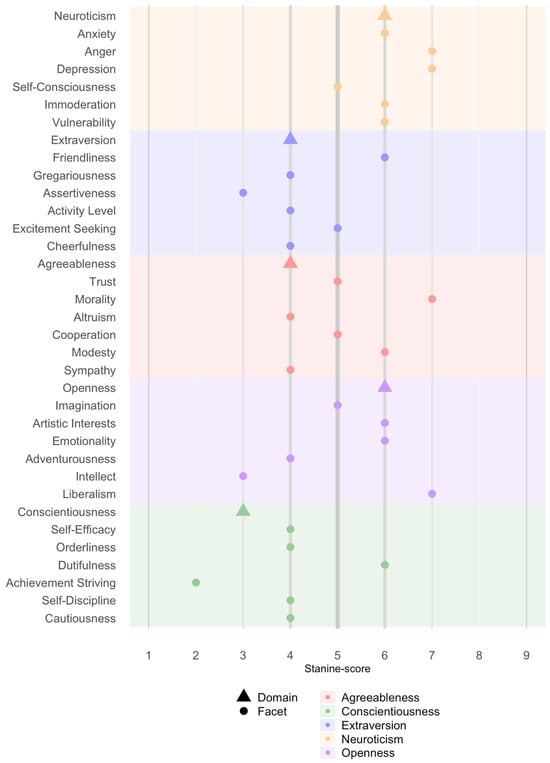
Figure 1
Open AccessArticle
The Role of Multiple Academic Identities When Implementing UNSDGs Within Marketing Curricula in UK Higher Education
by
Samreen Ashraf, Ediz Edip Akcay and Martyn Polkinghorne
Trends High. Educ. 2025, 4(4), 70; https://doi.org/10.3390/higheredu4040070 - 18 Nov 2025
Abstract
►▼
Show Figures
Achieving the United Nations Sustainable Development Goals (UNSDGs) is considered to be imperative for the future security and sustainability of the world. Universities are viewed as being a key industry to support the achievement of the goals by the target date of 2030.
[...] Read more.
Achieving the United Nations Sustainable Development Goals (UNSDGs) is considered to be imperative for the future security and sustainability of the world. Universities are viewed as being a key industry to support the achievement of the goals by the target date of 2030. Previous research undertaken has attempted to understand how the goals can be successfully implemented within the university curricula, and although various processes for implementation have been suggested, no previous studies have examined the role of identity or the impact that this may have on the implementation of the UNSDGs. In this study, specific attention has been applied to the existing literature relating to the barriers to implementation, the role of identity, and the impact on implementation to understand the roles that personal, academic, and organizational identities play when implementing UNSDGs within higher education. The research undertaken has employed a qualitative inductive approach focused specifically upon the marketing curriculum. Semi-structured interviews were conducted with the academics working at UK higher education institutions. Findings from the thematic analysis undertaken found that there is a complex interchange between these identities that significantly influences the extent to which the goals have been implemented successfully. In addition, multiple barriers have been identified that prevent successful implementation of the goals.
Full article
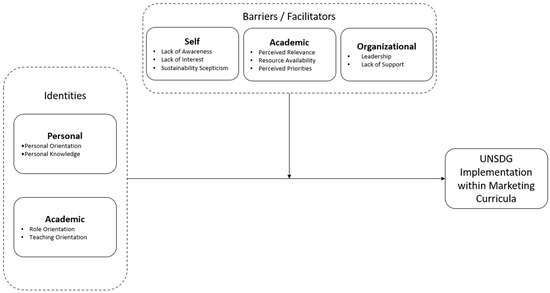
Figure 1
Open AccessArticle
Higher Education Dropout and Youth Unemployment in Slovenia, 2011–2019: First Empirical Evidence
by
Rado Pezdir
Trends High. Educ. 2025, 4(4), 69; https://doi.org/10.3390/higheredu4040069 - 14 Nov 2025
Abstract
►▼
Show Figures
This paper presents the first systematic attempt to quantify higher education dropout rates in Slovenia and to examine their relationship with youth unemployment. Using annual data for the period 2011–2019, dropout rates were estimated based on project V5-2360, while youth unemployment data were
[...] Read more.
This paper presents the first systematic attempt to quantify higher education dropout rates in Slovenia and to examine their relationship with youth unemployment. Using annual data for the period 2011–2019, dropout rates were estimated based on project V5-2360, while youth unemployment data were obtained from Eurostat. The study applies descriptive analysis, cointegration tests and a Bayesian Vector Autoregression (BVAR) with Minnesota priors, which is well suited for small samples. Three hypotheses are tested: that dropout and unemployment are inversely related, that higher unemployment reduces dropout, and that unemployment shocks are more persistent than dropout shocks. The empirical results broadly confirm these expectations. Dropout and unemployment move in opposite directions, unemployment shocks reduce dropout, and youth unemployment displays strong hysteresis. While the small sample requires cautious interpretation, the use of Bayesian VAR provides methodologically robust inference under data constraints. Beyond its national contribution, the Slovenian case carries broader implications for small post-socialist and open economies, where structural rigidities in higher education intersect with persistent labour market challenges. The findings underline the potential for higher education to act as a countercyclical buffer and highlight the importance of coordinated education and labour market policies. By linking dropout and unemployment dynamics for the first time in Slovenia, this study contributes new evidence to the international literature and opens avenues for comparative research across European higher education systems.
Full article

Graphical abstract
Open AccessArticle
Towards Personalized Education in Life Sciences: Tailoring Instruction to Students’ Prior Knowledge and Interest Through Machine Learning
by
Samuel Tobler and Katja Köhler
Trends High. Educ. 2025, 4(4), 68; https://doi.org/10.3390/higheredu4040068 - 12 Nov 2025
Abstract
►▼
Show Figures
Undergraduate life science education faces high attrition rates, especially among students from underrepresented groups. These disparities are often linked to differences in prior knowledge, self-efficacy, and interest, which are rarely addressed in traditional lecture-based instruction. This work explores the use of machine learning-based
[...] Read more.
Undergraduate life science education faces high attrition rates, especially among students from underrepresented groups. These disparities are often linked to differences in prior knowledge, self-efficacy, and interest, which are rarely addressed in traditional lecture-based instruction. This work explores the use of machine learning-based Intelligent Tutoring Systems (ITSs) to support personalized instruction in biology education by examining stochasticity in molecular systems. Accordingly, we developed and validated a Random Forest classification model and used it to assign instructional materials based on students’ prior knowledge and interests. We then applied the model in an introductory biology classroom and individually estimated the most promising instructional format. Results show that the most effective instruction can be reliably predicted from student performance and interest profiles, and model-based assignments may help reduce pre-existing opportunity gaps. Thus, machine-learning-driven instruction holds promise for enhancing equity in life science education by aligning materials with students’ needs, potentially reducing differences in achievement, self-efficacy, and cognitive load, which might be relevant to promoting underrepresented students. To facilitate a straightforward implementation for educators facing similar challenges associated with teaching molecular stochasticity, we developed an open-access ITS tool and provided a scalable approach for developing similar personalized learning tools.
Full article

Figure 1
Open AccessArticle
Understanding How Students Unwilling to Enroll in University Develop Self-Direction in Japanese Higher Education: A Multi-Group Structural Equation Modeling Approach Based on Reasons for Unwilling Enrollment
by
Ryota Tokioka
Trends High. Educ. 2025, 4(4), 67; https://doi.org/10.3390/higheredu4040067 - 10 Nov 2025
Abstract
►▼
Show Figures
In Japan, where competitive entrance exams are widespread, many students experience unwilling enrollment, entering a university that they do not wish to attend. This can hinder adjustment and increase the risk of dropping out, making support for academic self-direction essential. This study empirically
[...] Read more.
In Japan, where competitive entrance exams are widespread, many students experience unwilling enrollment, entering a university that they do not wish to attend. This can hinder adjustment and increase the risk of dropping out, making support for academic self-direction essential. This study empirically examined a model of how students develop self-direction. A survey was conducted with 336 individuals who had graduated within the past five years and experienced unwilling enrollment. Based on their reasons, participants were classified into two groups: those unwillingly enrolled yet intending to pursue higher education (n = 241), and those unwillingly enrolled owing to a lack of intent to pursue higher education (n = 95). Multi-group structural equation modeling showed that “Trusting Relationships with Others” and “Having Time and Space for Self-Reflection” promoted both “Discovering Personal Meaning in the Enrolled University” and “Clarification of Career Goals,” which in turn fostered “Development of Self-Direction.” Additionally, for those who intended to pursue higher education, “Realization of Experiences Unique to the Enrolled University” played a greater role, while for those lacking such intent, “Clarification of Career Goals” was more influential. These results suggest that tailored support, aligned with students’ reasons for unwillingness, is the key to fostering their self-direction.
Full article

Figure 1
Open AccessArticle
Navigating Intercultural Virtual Collaboration for Global Citizenship Education: Synchronous and Asynchronous Modalities
by
Ingrid Van Rompay-Bartels, Luana Ferreira-Lopes and Clinton Watkins
Trends High. Educ. 2025, 4(4), 66; https://doi.org/10.3390/higheredu4040066 - 27 Oct 2025
Abstract
►▼
Show Figures
This paper investigates the advantages and challenges associated with synchronous and asynchronous activities in intercultural virtual collaboration (IVC) projects, particularly in relation to student satisfaction and learning outcomes. This study draws parallels between two distinct IVC projects. The first facilitated real-time interaction among
[...] Read more.
This paper investigates the advantages and challenges associated with synchronous and asynchronous activities in intercultural virtual collaboration (IVC) projects, particularly in relation to student satisfaction and learning outcomes. This study draws parallels between two distinct IVC projects. The first facilitated real-time interaction among students, lecturers, and peers from partner universities in the Netherlands and Japan. In contrast, the second project involved separate live classes led by local instructors in the Netherlands and Spain and featured asynchronous interactions among peers. This latter arrangement required students to exercise a greater degree of autonomy in their collaborative efforts. In both IVC projects, students developed a business case study that explored the influence of cultural factors on international marketing strategies. They participated in discussions and reflective exercises concerning the issue of greenwashing within the selected company. Our research employs data derived from students’ final business case reports and satisfaction surveys. The surveys include both closed and open-ended questions to assess the effectiveness of the distinct IVC formats. Our research provides insights into the impact of the IVC formats on the student experience and learning. Findings indicate no substantial differences in the quality of work produced between the two formats; however, student satisfaction was notably higher in the synchronous model, highlighting that the way interactions are structured impacts the collaborative experience, even when final outputs are similar. This study offers important insights for educators navigating the challenges of virtual teaching and for policymakers looking to use digital technologies to foster a globally aware and responsible generation in an increasingly digital world.
Full article

Figure 1
Open AccessReview
Harnessing Large Language Models for Scalable and Effective Formative Assessment in Higher Education: A Review
by
Charith Narreddy, Steve Joordens and Sapolnach Prompiengchai
Trends High. Educ. 2025, 4(4), 65; https://doi.org/10.3390/higheredu4040065 - 22 Oct 2025
Abstract
Formative assessment is an integral component of higher education, fostering student learning through feedback, reflection, and iterative improvement. However, despite its pedagogical importance, widespread adoption of formative assessment is often hindered by time constraints, resource limitations, and scalability challenges. The objective of this
[...] Read more.
Formative assessment is an integral component of higher education, fostering student learning through feedback, reflection, and iterative improvement. However, despite its pedagogical importance, widespread adoption of formative assessment is often hindered by time constraints, resource limitations, and scalability challenges. The objective of this study is to examine how large language models (LLMs) offer a potential solution to support and enhance formative assessment in higher education across diverse educational contexts by enabling automated, personalized, and scalable feedback that is sustainable and accessible. In this review, we comprehensively examine cutting-edge research and applications of LLMs in various components of formative assessment, including feedback generation, student self-assessment, peer review, and instructor support within the context of higher education. We explore the opportunities LLMs present in enhancing learning outcomes associated with formative assessments and current research gaps while critically discussing the challenges in practical implementations of integrating LLM-driven formative assessments in real-world classrooms. By synthesizing current advancements, this review provides educators and researchers with insights into the transformative potential and responsible implementation of LLM-driven formative assessments in higher education.
Full article
Open AccessArticle
Food Insecurity and Personal Appearance Distress Among College Students: A Call for Help
by
Marcela D. Radtke, Rachel E. Scherr, Dana I. Alvarez Mendoza, Brittany M. Loofbourrow, Karen Stradford Boyce, Emily Sklar and Gretchen L. George
Trends High. Educ. 2025, 4(4), 64; https://doi.org/10.3390/higheredu4040064 - 18 Oct 2025
Abstract
►▼
Show Figures
Given the nexus between food insecurity and body dissatisfaction, a deeper understanding of this complex relationship in college students is needed. The purpose of this cross-sectional study, using the American College Health Association—National College and Health Assessment 2021 (n = 2003) at
[...] Read more.
Given the nexus between food insecurity and body dissatisfaction, a deeper understanding of this complex relationship in college students is needed. The purpose of this cross-sectional study, using the American College Health Association—National College and Health Assessment 2021 (n = 2003) at a large public university, was to explore the associations between food insecurity, personal appearance distress, and compensatory behaviors associated with body dissatisfaction. An analysis of variance with Tukey’s post hoc comparisons was performed to assess the relationship of outcomes associated with personal appearance distress by food security status. Structural equation modeling, using multivariable logistic and ordinal regression, were constructed to explore the impact of personal appearance distress, perception of body weight, weight control attempts, and dietary behaviors, adjusting for age, sex, race/ethnicity, body mass index, and food security status. Food insecurity was associated with lower grade point average, higher overall stress, and personal appearance distress. Personal appearance distress was associated with fewer servings of vegetables (p = 0.006) and fruits (p = 0.01), higher perceived body weight (p < 0.001), and more weight modification attempts (p < 0.05). The associations between food insecurity, personal appearance distress, and compensatory behaviors could extend to disordered eating behaviors, necessitating awareness and interventions from college campus programming and administration.
Full article

Figure 1
Open AccessArticle
Exploring Success Factors for Underserved Graduate Students in STEM
by
Karen M. Collier and Wayne A. Hickman
Trends High. Educ. 2025, 4(4), 63; https://doi.org/10.3390/higheredu4040063 - 15 Oct 2025
Abstract
►▼
Show Figures
Inequalities in enrollment in STEM persist for those entering higher education as first-generation college students, underserved racial and ethnic groups, female and nonbinary individuals, and those from lower socioeconomic backgrounds. The current study aims to better understand the relationship students have with graduate
[...] Read more.
Inequalities in enrollment in STEM persist for those entering higher education as first-generation college students, underserved racial and ethnic groups, female and nonbinary individuals, and those from lower socioeconomic backgrounds. The current study aims to better understand the relationship students have with graduate school success factors by redistributing the Graduate Student Success Survey+ (GSSS+) at an R2 institution in the southeastern United States. Exploratory factor analysis was used to test the survey’s validity, with 242 participants. A 7-factor, 40-item model was developed, comprising the following subscales: mentor support, peer support, imposter phenomenon, financial support, microaggressions (related to race and gender), access and opportunity (for research, writing, and presentations), and resilience. Item analysis identified perceived barriers (e.g., microaggressions, imposter phenomenon, and financial stress) for underserved students (i.e., females, underserved racial and ethnic groups, and part-time students). Regression analysis on resilience revealed a positive relationship with mentor support, peer support, and financial support. A negative relationship with resilience was associated with a greater perception of imposter phenomenon. Findings from this study underscore the need for additional support from mentors and other university entities to foster a stronger sense of resilience in students, along with increased opportunities for participation in research, academic writing, and publication.
Full article

Figure 1
Open AccessArticle
Regenerative Education Design: A Co-Creative Exploration of Online Academic Learning
by
Mieke T. A. Lopes Cardozo, Thevuni Kotigala, Thursica Kovinthan Levi, Aye Aye Nyein, Naw Tha Ku Paul, Sidsel Palle Petersen and Melina Merdanovic
Trends High. Educ. 2025, 4(4), 62; https://doi.org/10.3390/higheredu4040062 - 14 Oct 2025
Abstract
►▼
Show Figures
This article explores applying regenerative development approaches in an Amsterdam-based university course on “Education and International Development” during the COVID-19 pandemic. A transnational team examined possibilities and challenges in virtual/hybrid learning, focusing on co-creative pedagogies to enhance engagement and mutual learning. The study
[...] Read more.
This article explores applying regenerative development approaches in an Amsterdam-based university course on “Education and International Development” during the COVID-19 pandemic. A transnational team examined possibilities and challenges in virtual/hybrid learning, focusing on co-creative pedagogies to enhance engagement and mutual learning. The study uses auto-ethnographic narratives, reflection questions, and student insights to reflect on critical, transgressive, decolonising, and contemplative pedagogies. Findings highlight three design premises for regenerative approaches to higher education: paradigm shifting for purpose-driven education; living system thinking for co-creative pedagogy; and holistic developmental learning for being-education. This research contributes to innovative educational practices in international fields of study and invites readers in a reflective reading experience.
Full article
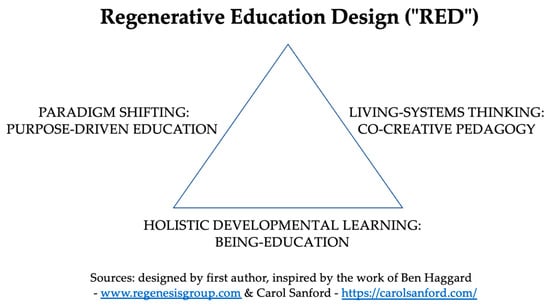
Figure 1
Open AccessReview
Student-Centred Pedagogies in Post-Bologna Higher Education: Research Trends from 2010 to 2020
by
Tatiana Sanches and Ana Luísa Paz
Trends High. Educ. 2025, 4(4), 61; https://doi.org/10.3390/higheredu4040061 - 14 Oct 2025
Abstract
►▼
Show Figures
The Bologna Process and the definition of the European Higher Education Area had a profound impact on higher education in Europe after 1999. But how exactly did this change the classroom, and how did research respond? This literature review aimed to identify changes
[...] Read more.
The Bologna Process and the definition of the European Higher Education Area had a profound impact on higher education in Europe after 1999. But how exactly did this change the classroom, and how did research respond? This literature review aimed to identify changes in the literature on learning and teaching processes in higher education concerning organisation, pedagogical approaches, and curricular practices in the post-Bologna period (2010–2020) and to determine the main changes or transformations resulting from the Bologna Process. The research was conducted using the Scopus and Web of Science databases, and a set of 86 articles was defined with a PRISMA model. The procedure yielded three main categories concerning (i) global issues in teaching and learning processes, (ii) specifically active methodologies and (iii) the integration of ICT in higher education (HE) environments. Additionally, the research experimented with a fourth category concerning (iv) the cross-continental impact of the Bologna Process. The review indicates that the post-Bologna period was both important as a research theme and that these subjects underlining a student-centred education were impactful to the EEHA and even worldwide. However, most research also highlights the need to investigate and monitor the use of active and digital methodologies, carefully adapting to the diversity of students, universities, and cultures.
Full article
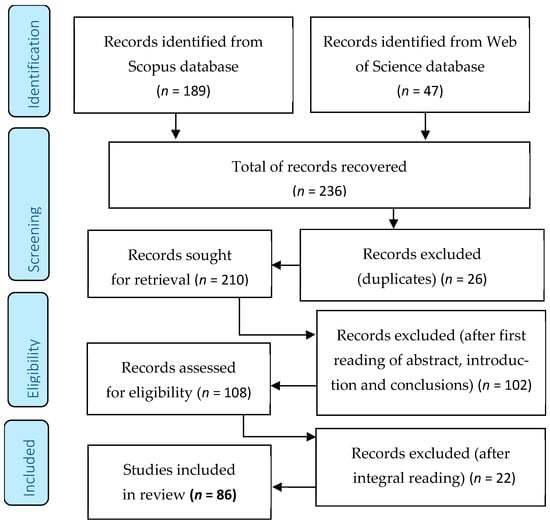
Figure 1
Open AccessArticle
Social Factors Causing Burnout of Disabled Students: Views of One Group of Allies of Disabled People
by
Gregor Wolbring and Alexandre J. Paquette
Trends High. Educ. 2025, 4(4), 60; https://doi.org/10.3390/higheredu4040060 - 14 Oct 2025
Cited by 1
Abstract
Burnout among students is a widely recognized concern, yet little research has focused on the experiences of disabled students and even less on the social factors at and off campus that contribute to their burnout. To address this gap, we surveyed 91 undergraduate
[...] Read more.
Burnout among students is a widely recognized concern, yet little research has focused on the experiences of disabled students and even less on the social factors at and off campus that contribute to their burnout. To address this gap, we surveyed 91 undergraduate students enrolled in a critical disability studies course at a Canadian university using an online qualitative survey approach. These students, many of whom see themselves as allies of disabled people, were asked whether they believe disabled students are at risk of burnout and what they perceive to be the causes. The majority viewed disabled students as being at significant risk, and 92% identified the social environment as the contributor. Attitudinal inaccessibility, including discrimination, stigma, and exclusion, has emerged as the leading factor in both university settings and broader societal contexts. These findings suggest that interventions to reduce burnout must address both educational environments and the wider lived realities of disabled students. This study contributes to the limited literature on burnout among disabled students and highlights the importance of ally perspectives in understanding and addressing systemic contributors to burnout.
Full article
Open AccessArticle
Examining Student Perceptions of AI-Driven Learning: User Experience and Instructor Credibility in Higher Education
by
Blake C. Colclasure, Taylor K. Ruth, Victoria Beasley and Tyler Granberry
Trends High. Educ. 2025, 4(4), 59; https://doi.org/10.3390/higheredu4040059 - 13 Oct 2025
Abstract
►▼
Show Figures
The increasing prevalence of artificial intelligence (AI) in higher education has established the need to examine the implications of specific AI-based technologies. We analyzed students’ perceptions of Packback, an AI-driven discussion board platform, in a large-enrollment undergraduate course at the University of Tennessee,
[...] Read more.
The increasing prevalence of artificial intelligence (AI) in higher education has established the need to examine the implications of specific AI-based technologies. We analyzed students’ perceptions of Packback, an AI-driven discussion board platform, in a large-enrollment undergraduate course at the University of Tennessee, United States. Valid and reliable quantitative survey instruments were used to measure students’ (n = 96) user experience (UX) of Packback and their perceptions of instructors who require the use of AI platforms in their courses. Data were analyzed to determine how students’ personal characteristics, prior use of Packback, and the UX of Packback influence their perceptions of the credibility (competence, goodwill, trustworthiness) of instructors who require the use of AI platforms. Findings indicated that students had an overall favorable experience of the Packback platform, despite moderate variability. For the credibility of instructors who require the use of AI technologies, students reported a moderate-to-high belief of competence, a moderate belief of goodwill, and a moderate-to-high belief of trustworthiness. A significant model was produced to explain the variance in students’ perception of teacher credibility. Female students and students who had more favorable UX were significantly associated with having higher beliefs in instructor credibility. Although the use of AI platforms can improve efficiency in teaching and learning, our data suggest it can also influence students’ perceptions of instructor credibility.
Full article

Figure 1
Open AccessReview
From Enrollment to Graduation: Pathways to Success in STEM Programs in Ibero-American Countries
by
Alexandra R. Costa, Marina Sousa, Camila Fior, Claudia P. P. Canal, Rubia Cobo-Rendón, Karla Lobos, María José Ruiz-Melero, Marta Sainz-Gómez and Leandro S. Almeida
Trends High. Educ. 2025, 4(4), 58; https://doi.org/10.3390/higheredu4040058 - 9 Oct 2025
Abstract
STEM (Science, Technology, Engineering & Mathematics) programs hold significant social and economic relevance, as the technological innovation that sustains a country’s competitiveness depends on them. This article compares research on STEM programs in Portuguese- and Spanish-speaking countries, specifically Brazil, Chile, Portugal, and Spain.
[...] Read more.
STEM (Science, Technology, Engineering & Mathematics) programs hold significant social and economic relevance, as the technological innovation that sustains a country’s competitiveness depends on them. This article compares research on STEM programs in Portuguese- and Spanish-speaking countries, specifically Brazil, Chile, Portugal, and Spain. More specifically, it aims to reflect on the social and economic relevance of STEM programs; vocational choices and the social stereotypes associated with these fields; the variables that influence academic success, retention, and graduation rates; and the measures implemented, either nationally or by Higher Education Institutions (HEIs), to promote access and success in these programs. We conducted qualitative research, analyzing official documents and peer-reviewed articles that describe the higher education landscape in the selected countries. Results show that in all four countries studied, there is a growing demand for STEM graduates. However, concerns remain about high dropout and failure rates, as well as the lower participation of women and students from disadvantaged socioeconomic backgrounds or ethnic minorities. Some measures have been implemented by the governments of these countries to promote greater democratization of access and academic success for these students. Nevertheless, inequalities persist, suggesting the need to increase investment in practices and policies that encourage young people, especially those from more disadvantaged groups, to engage early in STEM domains.
Full article
Open AccessArticle
“It Was Horrible!” Understanding the Transition Experiences of Direct Year 2 Entry Students in Computer Science
by
Mireilla Bikanga Ada
Trends High. Educ. 2025, 4(4), 57; https://doi.org/10.3390/higheredu4040057 - 8 Oct 2025
Abstract
►▼
Show Figures
While first-year transitions are well studied, less is known about students who enter directly into Year 2 of a four-year Scottish Computing Science degree via international foundation programmes, UK colleges, or high schools. This study investigated their academic preparedness, use of AI tools,
[...] Read more.
While first-year transitions are well studied, less is known about students who enter directly into Year 2 of a four-year Scottish Computing Science degree via international foundation programmes, UK colleges, or high schools. This study investigated their academic preparedness, use of AI tools, English language confidence, and transition challenges. Using a mixed-methods design, 77 students completed a survey with Likert-scale and open-ended items. Findings indicate gaps in programming skills, independent learning, and understanding academic expectations. Many students reported feeling a sense of low social belonging after joining pre-established cohorts. AI tools were commonly used for programming support and concept clarification, but they offered limited emotional reassurance. Students recommended clearer academic alignment, a tailored induction process, compulsory social events, and peer mentoring. This study advocates for equity-driven transition models that cater to the diverse needs of direct entrants, thereby fostering inclusion, belonging, and success.
Full article

Figure 1
Open AccessArticle
Behind University Students’ Academic Success: Exploring the Role of Emotional Intelligence and Cognitive Test Anxiety
by
Aikaterini Vasiou, Eleni Vasilaki, Konstantinos Mastrothanasis and Angelos Gkontelos
Trends High. Educ. 2025, 4(3), 56; https://doi.org/10.3390/higheredu4030056 - 20 Sep 2025
Abstract
►▼
Show Figures
University life can be a period of growth and development, but it is also a time of significant stress and challenge. Thus, the study aimed to explore factors with the potential to exert facilitative and debilitative influence on university students’ academic performance. A
[...] Read more.
University life can be a period of growth and development, but it is also a time of significant stress and challenge. Thus, the study aimed to explore factors with the potential to exert facilitative and debilitative influence on university students’ academic performance. A research project was designed by putting together emotional intelligence and test anxiety, as two pillars that can adequately explain performance in educational contexts. The sample consisted of 205 students from the Department of Primary Education at the University of Crete. Participants completed the Emotional Intelligence Scale and the Cognitive Test Anxiety Scale-Revised and agreed to have their responses paired with their Grade Point Average (GPA) of all passed courses as well. Analyses tested the effect of the identified variables on GPA. A series of correlational analyses was conducted to explore the relationships among the above-mentioned variables. Increased worry was associated with decreases in GPA, while increased emotional intelligence was associated with increases in GPA. Moreover, the mediating role of cognitive test anxiety between emotional intelligence and academic performance emerged, indicating that emotional intelligence relates to GPA primarily indirectly. The results shed light on the impact these factors have on students’ academic outcomes and highlight the importance of developing a multifaceted intervention model that supports emotional intelligence and reduces worry in higher education.
Full article

Figure 1
Open AccessArticle
Different Sides of University Life: An Exploratory Study Investigating How Multiple Visits to a Campus Nurture a Rounded View of the Setting and Strengthen Intentions Towards Higher Education Progression
by
Cherry Canovan, Hibah Sohail and Anna Graham
Trends High. Educ. 2025, 4(3), 55; https://doi.org/10.3390/higheredu4030055 - 19 Sep 2025
Abstract
The evidence base supporting practices to widen participation in higher education, such as campus visits and multi-intervention programs for younger students, remains limited. In order to address this gap, this exploratory study examines the impact of repeated university campus exposure on primary-aged children
[...] Read more.
The evidence base supporting practices to widen participation in higher education, such as campus visits and multi-intervention programs for younger students, remains limited. In order to address this gap, this exploratory study examines the impact of repeated university campus exposure on primary-aged children in the UK. We studied the influence of a campus tour on the views of a group of 78 primary school children who had visited the setting on a previous occasion. Our cohort (32M, 45F, aged 10–11) was drawn from schools with high populations of pupils from low-socioeconomic status backgrounds. Using a pre- and post-visit survey design, we assessed changes in perceptions following a second campus tour, building on a prior visit. We found that while one visit was enough to establish basic perceptions—for example, a university is big not small—a second visit allowed participants to see a different side of the university experience, adding nuance, expanding university-related vocabulary, and increasing comfort with the campus environment. Notably, repeat visits strengthened intentions to pursue higher education. We conclude that multiple campus visits benefit low-participation groups by fostering familiarity and exposing younger pupils to different motivations for university attendance. While this study provides a useful foundation from which to explore this area, further work is needed to address limitations such as the small sample size and the UK-specific context.
Full article
Highly Accessed Articles
Latest Books
E-Mail Alert
News
Topics
Topic in
Education Sciences, Healthcare, Merits, Sustainability, Trends in Higher Education
Establishing Professional Competency and Talent Cultivation Strategies in the Post-Pandemic Generation Based on the Sustainability Education Development
Topic Editors: Chia-Li Lin, Chi-Yo Huang, Chihhung ChenDeadline: 31 December 2025

Conferences
Special Issues
Special Issue in
Trends in Higher Education
AI Technology in Higher Education: A Matter of Fashion, Fetish, or Fantasy?
Guest Editor: Andrea ValenteDeadline: 30 December 2025
Special Issue in
Trends in Higher Education
Artificial Intelligence-Powered Higher Education: A New Era of Learning, Rights Protection, and Human-Machine Synergy
Guest Editors: Carlos Hervás-Gómez, María Dolores Díaz-Noguera, Liliana Mâță, Nadia BarkocziDeadline: 30 January 2026
Special Issue in
Trends in Higher Education
Evidence-Based Research-Oriented STEM Teacher Education: Research-Based Development of Curricula, Courses, Learning Resources and Pedagogical Models
Guest Editors: Johannes Pernaa, Maija Aksela, Outi HaatainenDeadline: 30 January 2026
Special Issue in
Trends in Higher Education
Interdisciplinary and Multi-Scalar Design and Research Models in Architectural Practice and Education
Guest Editors: Asma Mehan, Sina MostafaviDeadline: 28 February 2026



